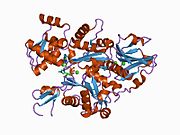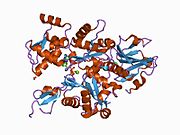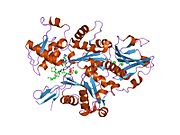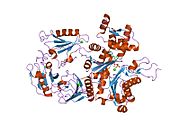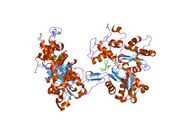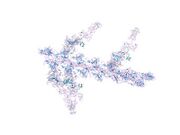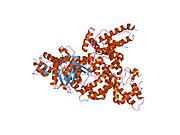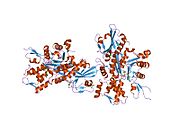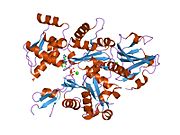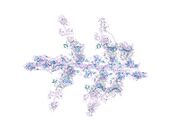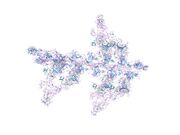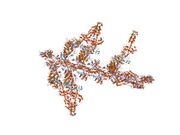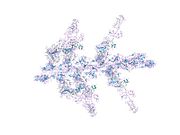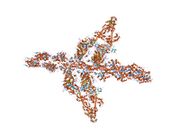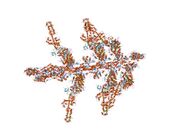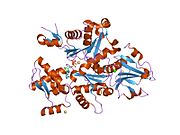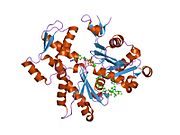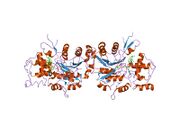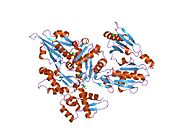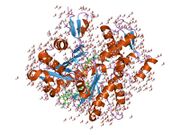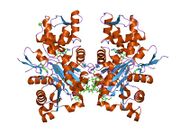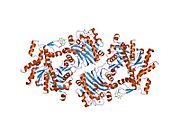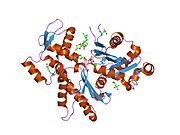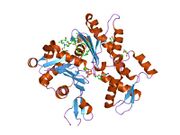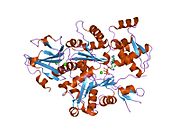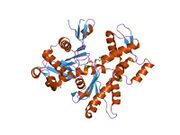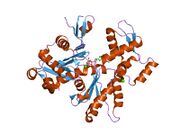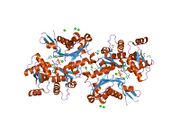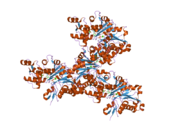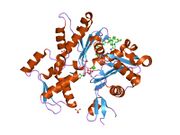Biology:ACTG1
 Generic protein structure example |
Gamma-actin is a protein that in humans is encoded by the ACTG1 gene.[1] Gamma-actin is widely expressed in cellular cytoskeletons of many tissues; in adult striated muscle cells, gamma-actin is localized to Z-discs and costamere structures, which are responsible for force transduction and transmission in muscle cells. Mutations in ACTG1 have been associated with nonsyndromic hearing loss and Baraitser-Winter syndrome, as well as susceptibility of adolescent patients to vincristine toxicity.
Structure
Human gamma-actin is 41.8 kDa in molecular weight and 375 amino acids in length.[2] Actins are highly conserved proteins that are involved in various types of cell motility, and maintenance of the cytoskeleton. In vertebrates, three main groups of actin isoforms, alpha, beta and gamma have been identified.[3]
The alpha actins are found in muscle tissues and are a major constituent of the sarcomere contractile apparatus. The beta and gamma actins co-exist in most cell types as components of the cytoskeleton, and as mediators of internal cell motility. Actin, gamma 1, encoded by this gene, is found in non-muscle cells in the cytoplasm, and in muscle cells at costamere structures, or transverse points of cell-cell adhesion that run perpendicular to the long axis of myocytes.[4][5][6]
Function
In myocytes, sarcomeres adhere to the sarcolemma via costameres, which align at Z-discs and M-lines.[7] The two primary cytoskeletal components of costameres are desmin intermediate filaments and gamma-actin microfilaments.[8] It has been shown that gamma-actin interacting with another costameric protein dystrophin is critical for costameres forming mechanically strong links between the cytoskeleton and the sarcolemmal membrane.[9][10] Additional studies have shown that gamma-actin colocalizes with alpha-actinin and GFP-labeled gamma actin localized to Z-discs, whereas GFP-alpha-actin localized to pointed ends of thin filaments, indicating that gamma actin specifically localizes to Z-discs in striated muscle cells.[11][12][13]
During development of myocytes, gamma actin is thought to play a role in the organization and assembly of developing sarcomeres, evidenced in part by its early colocalization with alpha-actinin.[14] Gamma-actin is eventually replaced by sarcomeric alpha-actin isoforms,[15][16][17] with low levels of gamma-actin persisting in adult myocytes which associate with Z-disc and costamere domains.[11][18][19]
Insights into the function of gamma-actin in muscle have come from studies employing transgenesis. In a skeletal muscle-specific knockout of gamma-actin in mice, these animals showed no detectable abnormalities in development; however, knockout mice showed muscle weakness and fiber necrosis, along with decreased isometric twitch force, disrupted intrafibrillar and interfibrillar connections among myocytes, and myopathy.[20]
Clinical Significance
An autosomal dominant mutation in ACTG1 in the DFNA20/26 locus at 17q25-qter was identified in patients with hearing loss. A Thr278Ile mutation was identified in helix 9 of gamma-actin protein, which is predicted to alter protein structure. This study identified the first disease causing mutation in gamma-actin and underlies the importance of gamma-actin as structural elements of the inner ear hair cells.[21] Since then, other ACTG1 mutations have been linked to nonsyndromic hearing loss, including Met305Thr.[22]
A missense mutation in ACTG1 at Ser155Phe has also been identified in patients with Baraitser-Winter syndrome, which is a developmental disorder characterized by congenital ptosis, excessively-arched eyebrows, hypertelorism, ocular colobomata, lissencephaly, short stature, seizures and hearing loss.[23][24]
Differential expression of ACTG1 mRNA was also identified in patients with Sporadic Amyotrophic Lateral Sclerosis, a devastating disease with unknown causality, using a sophisticated bioinformatics approach employing Affymetrix long-oligonucleotide BaFL methods.[25]
Single nucleotide polymorphisms in ACTG1 have been associated with vincristine toxicity, which is part of the standard treatment regimen for childhood acute lymphoblastic leukemia. Neurotoxicity was more frequent in patients that were ACTG1 Gly310Ala mutation carriers, suggesting that this may play a role in patient outcomes from vincristine treatment.[26]
Interactions
ACTG1 has been shown to interact with:
See also
References
- ↑ "Entrez Gene: ACTG1 actin, gamma 1". https://www.ncbi.nlm.nih.gov/sites/entrez?Db=gene&Cmd=ShowDetailView&TermToSearch=71.
- ↑ "Protein sequence for human ACTG1 (Uniprot ID: P63261)". http://www.heartproteome.org/copa/ProteinInfo.aspx?QType=Protein%20ID&QValue=P63261.
- ↑ "The functional importance of multiple actin isoforms". BioEssays 12 (7): 309–15. Jul 1990. doi:10.1002/bies.950120702. PMID 2203335.
- ↑ "Gamma actin, spectrin, and intermediate filament proteins colocalize with vinculin at costameres, myofibril-to-sarcolemma attachment sites". Cell Motility 3 (5–6): 449–62. 1983. doi:10.1002/cm.970030513. PMID 6420066.
- ↑ "A vinculin-containing cortical lattice in skeletal muscle: transverse lattice elements ("costameres") mark sites of attachment between myofibrils and sarcolemma". Proceedings of the National Academy of Sciences of the United States of America 80 (4): 1008–12. Feb 1983. doi:10.1073/pnas.80.4.1008. PMID 6405378. Bibcode: 1983PNAS...80.1008P.
- ↑ "Costameres are sites of force transmission to the substratum in adult rat cardiomyocytes". The Journal of Cell Biology 118 (6): 1411–20. Sep 1992. doi:10.1083/jcb.118.6.1411. PMID 1522115.
- ↑ "Striated muscle cytoarchitecture: an intricate web of form and function". Annual Review of Cell and Developmental Biology 18: 637–706. 2002. doi:10.1146/annurev.cellbio.18.012502.105840. PMID 12142273.
- ↑ "Diverse roles of the actin cytoskeleton in striated muscle". Journal of Muscle Research and Cell Motility 30 (5–6): 187–97. 2009. doi:10.1007/s10974-009-9193-x. PMID 19997772.
- ↑ 9.0 9.1 "The dystrophin complex forms a mechanically strong link between the sarcolemma and costameric actin". The Journal of Cell Biology 150 (5): 1209–14. Sep 2000. doi:10.1083/jcb.150.5.1209. PMID 10974007.
- ↑ "Costameres: the Achilles' heel of Herculean muscle". The Journal of Biological Chemistry 278 (16): 13591–4. Apr 2003. doi:10.1074/jbc.R200021200. PMID 12556452.
- ↑ 11.0 11.1 "Cytoplasmic gamma actin as a Z-disc protein". Biochemical and Biophysical Research Communications 286 (1): 156–63. Aug 2001. doi:10.1006/bbrc.2001.5353. PMID 11485322.
- ↑ "Evidence for gamma-actin as a Z disc component in skeletal myofibers". Experimental Cell Research 315 (2): 218–25. Jan 2009. doi:10.1016/j.yexcr.2008.10.021. PMID 19013151.
- ↑ "Cytoskeletal tropomyosin Tm5NM1 is required for normal excitation-contraction coupling in skeletal muscle". Molecular Biology of the Cell 20 (1): 400–9. Jan 2009. doi:10.1091/mbc.E08-06-0616. PMID 19005216.
- ↑ "A novel role for non-muscle gamma-actin in skeletal muscle sarcomere assembly". Experimental Cell Research 297 (1): 82–96. Jul 2004. doi:10.1016/j.yexcr.2004.02.012. PMID 15194427.
- ↑ "Gene switching in myogenesis: differential expression of the chicken actin multigene family". Biochemistry 20 (14): 4122–9. Jul 1981. doi:10.1021/bi00517a027. PMID 7284314.
- ↑ "The correlation between the synthesis of skeletal muscle actin, myosin heavy chain, and myosin light chain and the accumulation of corresponding mRNA sequences during myogenesis". Developmental Biology 86 (2): 483–92. Sep 1981. doi:10.1016/0012-1606(81)90206-2. PMID 7286410.
- ↑ "Dominant negative effect of cytoplasmic actin isoproteins on cardiomyocyte cytoarchitecture and function". The Journal of Cell Biology 131 (6 Pt 2): 1759–73. Dec 1995. doi:10.1083/jcb.131.6.1759. PMID 8557743.
- ↑ "Cytoplasmic gamma-actin expression in diverse animal models of muscular dystrophy". Neuromuscular Disorders 17 (7): 569–74. Jul 2007. doi:10.1016/j.nmd.2007.03.004. PMID 17475492.
- ↑ "Sorting of a nonmuscle tropomyosin to a novel cytoskeletal compartment in skeletal muscle results in muscular dystrophy". The Journal of Cell Biology 166 (5): 685–96. Aug 2004. doi:10.1083/jcb.200406181. PMID 15337777.
- ↑ "Cytoplasmic gamma-actin is not required for skeletal muscle development but its absence leads to a progressive myopathy". Developmental Cell 11 (3): 387–97. Sep 2006. doi:10.1016/j.devcel.2006.07.001. PMID 16950128.
- ↑ "A mutation in the gamma actin 1 (ACTG1) gene causes autosomal dominant hearing loss (DFNA20/26)". Journal of Medical Genetics 40 (12): 879–84. Dec 2003. doi:10.1136/jmg.40.12.879. PMID 14684684.
- ↑ "Multiphasic analysis of whole exome sequencing data identifies a novel mutation of ACTG1 in a nonsyndromic hearing loss family". BMC Genomics 14: 191. 18 March 2013. doi:10.1186/1471-2164-14-191. PMID 23506231.
- ↑ "De novo mutations in the actin genes ACTB and ACTG1 cause Baraitser-Winter syndrome". Nature Genetics 44 (4): 440–4, S1–2. Apr 2012. doi:10.1038/ng.1091. PMID 22366783.
- ↑ "Severe forms of Baraitser-Winter syndrome are caused by ACTB mutations rather than ACTG1 mutations". European Journal of Human Genetics 22 (2): 179–83. Feb 2014. doi:10.1038/ejhg.2013.130. PMID 23756437.
- ↑ "The LO-BaFL method and ALS microarray expression analysis". BMC Bioinformatics 13: 244. 24 September 2012. doi:10.1186/1471-2105-13-244. PMID 23006766.
- ↑ "Polymorphisms of the vincristine pathway and response to treatment in children with childhood acute lymphoblastic leukemia". Pharmacogenomics 15 (8): 1105–16. Jun 2014. doi:10.2217/pgs.14.68. PMID 25084203.
- ↑ "Mammalian CAP interacts with CAP, CAP2, and actin". Journal of Cellular Biochemistry 61 (3): 459–66. Jun 1996. doi:10.1002/(SICI)1097-4644(19960601)61:3<459::AID-JCB13>3.0.CO;2-E. PMID 8761950.
- ↑ "The beta-thymosin/WH2 domain; structural basis for the switch from inhibition to promotion of actin assembly". Cell 117 (5): 611–23. May 2004. doi:10.1016/S0092-8674(04)00403-9. PMID 15163409.
- ↑ "The actin binding site of thymosin beta 4 mapped by mutational analysis". The EMBO Journal 15 (2): 201–10. Jan 1996. doi:10.1002/j.1460-2075.1996.tb00350.x. PMID 8617195.
- ↑ "Plectin 1 links intermediate filaments to costameric sarcolemma through beta-synemin, alpha-dystrobrevin and actin". Journal of Cell Science 121 (Pt 12): 2062–74. Jun 2008. doi:10.1242/jcs.021634. PMID 18505798.
External links
- Human ACTG1 genome location and ACTG1 gene details page in the UCSC Genome Browser.
Further reading
- "The cleavage of host cell proteins by HIV-1 protease". Folia Biologica 42 (5): 227–30. 1997. doi:10.1007/BF02818986. PMID 8997639.
- "Ca2+ and pH determine the interaction of chromaffin cell scinderin with phosphatidylserine and phosphatidylinositol 4,5,-biphosphate and its cellular distribution during nicotinic-receptor stimulation and protein kinase C activation". The Journal of Cell Biology 119 (4): 797–810. Nov 1992. doi:10.1083/jcb.119.4.797. PMID 1331119.
- "HIV-1 protease cleaves actin during acute infection of human T-lymphocytes". AIDS Research and Human Retroviruses 8 (2): 291–5. Feb 1992. doi:10.1089/aid.1992.8.291. PMID 1540415. https://zenodo.org/record/1235231.
- "Treatment of Haemophilus aphrophilus endocarditis with ciprofloxacin". The Journal of Infection 24 (3): 317–20. May 1992. doi:10.1016/S0163-4453(05)80037-4. PMID 1602151.
- "Actin, troponin C, Alzheimer amyloid precursor protein and pro-interleukin 1 beta as substrates of the protease from human immunodeficiency virus". The Journal of Biological Chemistry 266 (22): 14548–53. Aug 1991. doi:10.1016/S0021-9258(18)98721-1. PMID 1907279.
- "Non-viral cellular substrates for human immunodeficiency virus type 1 protease". FEBS Letters 278 (2): 199–203. Jan 1991. doi:10.1016/0014-5793(91)80116-K. PMID 1991513.
- "Structure, chromosome location, and expression of the human gamma-actin gene: differential evolution, location, and expression of the cytoskeletal beta- and gamma-actin genes". Molecular and Cellular Biology 8 (4): 1775–89. Apr 1988. doi:10.1128/mcb.8.4.1775. PMID 2837653.
- "Botulinum C2 toxin ADP-ribosylates cytoplasmic beta/gamma-actin in arginine 177". The Journal of Biological Chemistry 263 (2): 696–700. Jan 1988. doi:10.1016/S0021-9258(19)35408-0. PMID 3335520.
- "Gamma-actin: unusual mRNA 3'-untranslated sequence conservation and amino acid substitutions that may be cancer related". Proceedings of the National Academy of Sciences of the United States of America 84 (9): 2575–9. May 1987. doi:10.1073/pnas.84.9.2575. PMID 3472224. Bibcode: 1987PNAS...84.2575C.
- "Isolation of a domain of villin retaining calcium-dependent interaction with G-actin, but devoid of F-actin fragmenting activity". European Journal of Biochemistry / FEBS 154 (1): 135–40. Jan 1986. doi:10.1111/j.1432-1033.1986.tb09368.x. PMID 3510866.
- "Nucleotide sequence of the human gamma cytoskeletal actin mRNA: anomalous evolution of vertebrate non-muscle actin genes". Nucleic Acids Research 14 (13): 5275–94. Jul 1986. doi:10.1093/nar/14.13.5275. PMID 3737401.
- "The evolution and complexity of the genes encoding the cytoskeletal proteins of human epidermal cells". Current Problems in Dermatology 11: 27–44. 1984. doi:10.1159/000408662. ISBN 978-3-8055-3752-0. PMID 6686106.
- "Isolation and characterization of full-length cDNA clones for human alpha-, beta-, and gamma-actin mRNAs: skeletal but not cytoplasmic actins have an amino-terminal cysteine that is subsequently removed". Molecular and Cellular Biology 3 (5): 787–95. May 1983. doi:10.1128/mcb.3.5.787. PMID 6865942.
- "Villin is a major protein of the microvillus cytoskeleton which binds both G and F actin in a calcium-dependent manner". Cell 20 (3): 839–47. Jul 1980. doi:10.1016/0092-8674(80)90330-X. PMID 6893424.
- "Microtubule associated protein MAP1A is an actin-binding and crosslinking protein". Cell Motility and the Cytoskeleton 29 (2): 110–6. 1995. doi:10.1002/cm.970290203. PMID 7820861.
- "Localization of the calcium-sensitive actin monomer binding site in gelsolin to segment 4 and identification of calcium binding sites". Biochemistry 34 (5): 1583–8. Feb 1995. doi:10.1021/bi00005a014. PMID 7849017.
- "Functional molecular complexes of human N-formyl chemoattractant receptors and actin". Journal of Immunology 151 (10): 5653–65. Nov 1993. PMID 8228254.
- "Human actin depolymerizing factor mediates a pH-sensitive destruction of actin filaments". Biochemistry 32 (38): 9985–93. Sep 1993. doi:10.1021/bi00089a014. PMID 8399167.
- "Thymosin beta 10 and thymosin beta 4 are both actin monomer sequestering proteins". The Journal of Biological Chemistry 268 (1): 502–9. Jan 1993. doi:10.1016/S0021-9258(18)54179-X. PMID 8416954.
- "Human mineralocorticoid receptor interacts with actin under mineralocorticoid ligand modulation". FEBS Letters 384 (2): 112–6. Apr 1996. doi:10.1016/0014-5793(96)00295-5. PMID 8612804.


